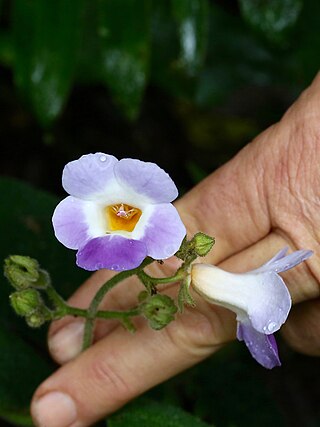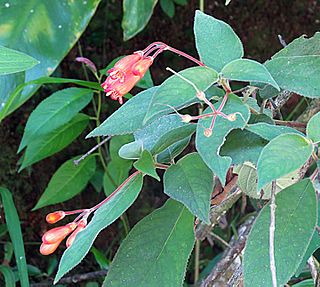
Columnea is a genus of around 200 species of epiphytic herbs and shrubs in the family Gesneriaceae, native to the tropics of the Americas and the Caribbean. The tubular or oddly shaped flowers are usually large and brightly colored – usually red, yellow, or orange – sometimes resembling a fish in shape. A common name is flying goldfish plants due to the unusual flower shape.

Kohleria is a New World genus of the flowering plant family Gesneriaceae. The plants are generally tropical herbs or subshrubs with velvety stems and foliage and brightly colored flowers with spots or markings in contrasting colors. They are rhizomatous and commonly include a period of dormancy in their growth cycle. The genus was revised in 1992 and was then recognized as having 19 species distributed in Central America and South America. phylogenetic in 2005 indicated that the epiphytic genus Capanea is derived from within Kohleria, and the two species of Capanea were subsequently transferred to Kohleria. The genus Pearcea is closely related.

Gesneria is a genus of flowering plants in the family Gesneriaceae. It contains 62 species which are native to islands of the Caribbean. The genus is classified in the tribe Gesnerieae along with the genera Bellonia, Pheidonocarpa, and Rhytidophyllum. Gesneria species are usually woody shrubs or subshrubs, and are unusual in the family in having alternately arranged leaves. A complete list of the accepted species and their synonyms can be found in the Smithsonian Institution's World Checklist of Gesneriaceae.

Gasteranthus is a genus of 35 species of herbs and soft-stemmed subshrubs in the flowering plant family Gesneriaceae. The species occur in Central America and South America, from southernmost Mexico to Bolivia. Numerous species are threatened with extinction, mainly due to deforestation. This is due to two reasons: For one thing, Gasteranthus species are native to countries in which destruction of primary forest runs rampant; also, these plants do not distribute well and therefore endemism is very frequent, for example on isolated mountain ranges.

Sinningia is a genus of flowering plants in the family Gesneriaceae. It is named after Wilhelm Sinning (1792–1874), a gardener of the Botanische Gärten der Friedrich-Wilhelms-Universität Bonn. There are about 65 species of tuberous herbaceous perennials, all occurring in Central and South America, with the greatest concentration of species occurring in southern Brazil.

Nematanthus is a genus of flowering plants in the family Gesneriaceae. All of its species are endemic to Brazil. Compared to other gesneriads, Nematanthus has leaves that are small, succulent, and hard-surfaced. The plant has a trailing, branching, and spreading habit; it is generally an epiphyte in nature and a hanging-basket plant in cultivation. The flower has fused petals. In some species, the flower has a "pouch" at the bottom. The fancied resemblance of such flowers to a goldfish gives these plants the common name goldfish plant or guppy plant.

Alloplectus is a genus of Neotropical plants in the family Gesneriaceae. A 2005 revision of the genus included five species, with the majority of species in the genus as traditionally circumscribed being transferred to Crantzia, Glossoloma, and Drymonia. Plants of the World Online currently accepts seven species.

Monopyle is a genus of plants in the family Gesneriaceae.
Napeanthus is a genus of plant in family Gesneriaceae. It includes 17 species of terrestrial, perennial herbs with rhizomes native to the tropical Americas, ranging from Mexico to Bolivia and southern Brazil.

Nautilocalyx is a genus of plants in the family Gesneriaceae. Its native range stretches from Costa Rica to southern Tropical America and to Trinidad. It is also found in Bolivia, Brazil, Colombia, Costa Rica, Ecuador, French Guiana, Guyana, Panamá, Peru, Suriname, Trinidad-Tobago and Venezuela.

Paradrymonia is a genus of flowering plants in family Gesneriaceae. It includes 11 species native to the tropical Americas, ranging from Honduras to Bolivia and northern Brazil.
Phinaea is a genus of flowering plants in family Gesneriaceae. It contains three species native to the Americas, including western and central Mexico, Cuba and Haiti, and Colombia and northern Brazil.

Rhytidophyllum is a genus of plant in family Gesneriaceae, native to the Caribbean islands and northern South America.

Glossoloma is a genus of Neotropical plants in the family Gesneriaceae. It includes 20 species which range from southern Mexico to Bolivia. The species in the genus were formerly placed in Alloplectus. They are subshrubs with the leaves clustered at the ends of branches, and tubular flowers.

Corytoplectus is a genus in the plant family Gesneriaceae. Plants from Corytoplectus are found in Bolivia, Brazil North, Colombia, Ecuador, Guyana, southwestern Mexico, Peru, Venezuela, in the cloud-forests of the high cordillera. The genus contains c. 12 species. The genus differs from the closely related Alloplectus in having an erect umbellate inflorescence and berries. The type species is C. capitatus.

Trichodrymonia is a genus of flowering plants belonging to the family Gesneriaceae.
Amalophyllon is a genus of flowering plants belonging to the family Gesneriaceae. It includes 13 species native to the tropical Americas, ranging from southern Mexico through Central America to Venezuela and Peru.

Codonanthopsis is a genus of flowering plants in the family Gesneriaceae. Its native range is from southern Mexico through tropical America to Bolivia and most of Brazil. Codonanthopsis species are generally trailing epiphytes with pale flowers. Most have a mutualistic relationship with tree-living ants: the plants provide the ants with food, including nectar, and give their nests structure and support, while the ants disperse the plants' seeds. The genus was considerably expanded in 2013 when species were transferred from Codonanthe. Some Codonanthopsis species are cultivated as houseplants, when they may be grown in hanging baskets.

Moussonia is a genus of plants in the family Gesneriaceae. Its native range stretches from Mexico to Central America. It is found in Costa Rica, El Salvador, Guatemala, Honduras, Mexico and Panamá.

Drymonia is a genus of flowering plants in the family Gesneriaceae. It includes 82 species native to the tropical Americas, ranging from southern Mexico through Central America and northern South America to Bolivia and southeastern Brazil.

















